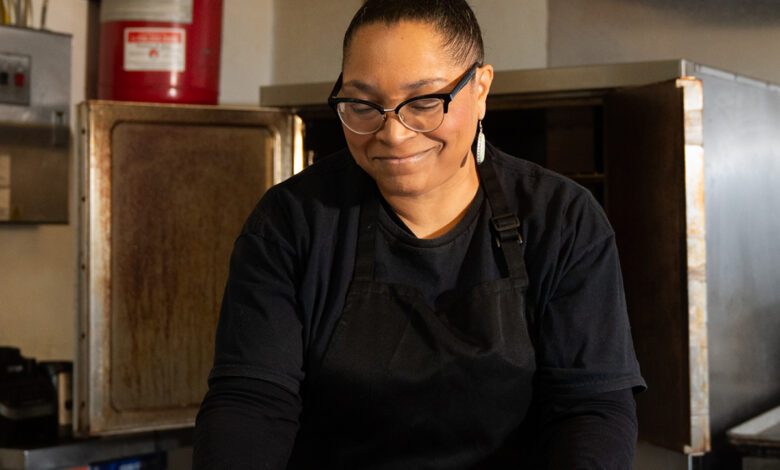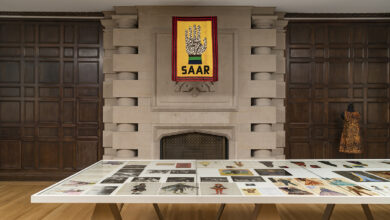Rewind: Bean pie, my brother?

“Bean pie, my brother?” was originally published in the issue of November 18, 2013. Since I first went in search of the sweet, custardy navy bean pie made in accordance with the dietary regimen prescribed by the late Elijah Muhammad, it hasn’t quite gone mainstream, but it might be easier to eat one. Plenty of online recipe churners can show you a method, as well as more august outlets like Saveur and Southern Living. Imani Muhammad is still making them and shipping them nationwide—and also hosting her own podcast, Conversations Over Pie. The Nation’s Supreme Bean Pie, relatively revitalized, is still baking at Mosque Maryam in South Shore and distributing whole pies at a handful of south-side locations. You can get one shipped, order one on Uber Eats, or just pick one up in Bronzeville or Olympia Fields at Shawn Michelle’s Homemade Ice Cream, which still makes its original chunky bean pie flavor, as well as a newer, smoother variant made with the pie custard recipe.
—Mike Sula, senior staff writer
The young man who met us at the front doors of Muhammad University of Islam wouldn’t let us in. He was polite yet firm when he told us they weren’t making bean pies that day. But my friends Peter Engler (eminent investigator of south-side culinary oddities) and Rob Lopata (occasional Reader contributor) had just toured the Nation of Islam’s neighboring Mosque Maryam a few days earlier, as part of the Chicago Architecture Foundation’s [now the Chicago Architecture Center’s] Open House Chicago. When they had asked about bean pies, their guide told them to come back during the week, when the university’s bakery would be in production.
We stood in the vestibule flummoxed, and it wasn’t until the same guy who had conducted the tour passed by and spotted us that we were let in. Sure, we could buy a pie, he told us—but not before some security measures. We took turns standing behind a screen while the guard patted us down, and then grabbed a seat in a row of chairs by the door while a perfect formation of white-shirted young boys filed past. Eventually, a blue-bedecked woman who introduced herself as Sister Medea came out with two official Nation of Islam Supreme Bean Pies. We forked over $18, and before we could ask too many questions, we were gently sent on our way. The university parking lot’s automatic metal gate—wide open when we turned off Stony Island—closed behind us when we pulled out.
Made from cooked, mashed, small navy beans, the bean pie is the iconic food of Black Muslims everywhere, but locating one in Chicago in recent years has been a hit-or-miss proposition. That’s surprising given the zeal Elijah Muhammad, the Nation’s leader for 41 years, had for navy beans. “Eat food that Allah (God) has prescribed for us,” he wrote in How to Eat to Live, a two-volume dietary guide for followers of the Nation, whose main points are repeated with the circularity of an industrial-sized mixer: “Even take little things such as beans. Allah (God) says that the little navy bean will make you live, just eat them. He said to me that even milk and bread would make us live. Just eat bread and milk—it is the best food. He said that a diet of navy beans would give us a life span of one hundred and forty years. Yet we cannot live ½ that length of time eating everything that the Christian table has set for us.”
In some ways Muhammad’s Nation of Islam diet was ahead of its time. He advocated eating unprocessed foods and mostly vegetables (definitely not pork) in moderation. On the other hand, it’s an extreme form of moderation. He advised eating just one meal per day, or every other day if you were strong, or—for those who could work up to it—once every 72 hours. “The European white race,” he wrote, “blessed with the privilege of eating the best food the earth provides, has taught us to eat the worst (divinely prohibited) foods. We eat all the time, three and four times a day. This is enough to wear out the intestines of a brass monkey.”
Though in How to Eat to Live he never precisely says why, Muhammad lists most legumes—lima beans, field peas, black-eyed peas, speckled peas, red peas, and brown peas—as among the divinely prohibited. The navy bean was the sole exception.
These rules, he wrote, came directly from the mouth of Wallace Fard Muhammad, who the protege asserted came to Detroit from Mecca to found the Nation of Islam (and then mysteriously disappeared en route to Chicago in 1934). And with him came the recipe for bean pie, according to Lance Shabazz, an archivist and historian of the Nation who says that the theory of the bean pie emerging as a substitute for sweet potato pie might have some validity. Elijah Muhammad doesn’t mention bean pie, but he’s pretty clear about sweet potatoes: “Sweet potatoes were never good for any human to eat. They are good for hogs, but not for you.” (That might have been a tough sell for African Americans new to the Nation. Sweet potato pie, which originated in the south, was likely the mingling of the cooking of enslaved Africans, who knew yams, and their European enslavers, who knew pie crust. It is enshrined in the soul food canon.)
In any case, Lance Shabazz says Fard Muhammad bestowed the first recipe for bean pie upon Elijah Muhammad and his wife, Clara, in the 30s in Detroit, though none of this is precisely stated in How to Eat to Live either.
But bean pie is in fact a convincing substitute for sweet potato pie. Built on a whole-wheat crust, with a filling of strained and mashed beans, butter, raw sugar, evaporated milk, eggs, cinnamon, and other baking spices, it develops a mildly sweet, dense, custardy understory, with a browned layer on top that one bean pie maker told me is the result of the butter rising and browning in the heat of the oven. If nobody tipped you off to the fact that you were eating pie made from mashed navy beans, you could be forgiven for thinking it was sweet potato or pumpkin pie.
Bean pie wasn’t the only Nation of Islam dish made with the miraculous navy bean—there was bean soup and bean bread—but it was certainly the most iconic, not just in Chicago but in any other city with a Nation of Islam presence.



In Chicago it used to be that you could reliably pick up a bean pie on the street—along with the latest issue of the Final Call—from a fastidiously dressed male member of the Nation of Islam, who might proffer, “Bean pie, my brother?” Lance Shabazz bemoans this sales tactic. “One of my pet peeves is that when Elijah Muhammad was present, we had bakeries all across this country. They baked the bean pie on the premises. We didn’t go on the street, on the corner selling pies, stopping traffic. I find it embarrassing because if you want a pie you should go to the bakery and get it. I’m talking about in New York City, where on major streets you may see brothers stopping cars at the light trying to sell a pie. We had the tractor trailers bringing pies and bringing newspapers up and down the east coast. It seemed to be more professional.”
The late Lana Shabazz, operator of a renowned bakery in New York City, was probably the Nation’s most famous bean pie maker. She cooked for Elijah Muhammad and Muhammad Ali—and in 1979 she authored the cookbook Cooking for the Champ. In Chicago there were at least three Nation of Islam bakeries on the south side at one time, most notably the Shabazz Bakery on 71st near Saint Lawrence. Khalilah Camacho Ali worked in all three before she married Muhammad Ali, becoming his second wife. Camacho Ali is emphatic when she says that, counter to most popular accounts, she wasn’t in any of those bakeries on the day she first met the Champ, but that’s where she was working at the time. And he was a customer.
Camacho Ali, who grew up in the Nation of Islam, says she learned to make pies from Elijah Muhammad himself. “That came about because I grew up in his house with his grandchildren,” she says. “When my mother was working or my dad was working, I was with him and his family. They had us all working in the house, working in the kitchen. We served. We were taught proper ways of cleaning and cooking our food, and this was part of our lifestyle. That’s when we learned how to make the bean soup and the bean pie.”
The bakeries where she worked are gone now, but independent bean pie makers still come and go. “Things change really fast in the bean pie world, it seems,” says Peter Engler, who has made a study of bean pies over the years. When he first came across one in the early 70s it was at the Hyde Park Co-op. “I saw these stacks of pies. I’m pretty sure these were the Shabazz pies. I bought one and I think I was surprised that it was sweet. It was just like a pumpkin pie. I’d buy one every now and then.” Later, in the 90s, Engler bought pies from the now-defunct Original Bean Pie Bakery for his coworkers in the molecular immunology lab at the University of Chicago. “Almost everybody in the lab liked them, especially the Chinese guys,” he says, which he chalks up to the Chinese appreciation for sweet bean desserts.
Such observations give credence to the idea that the bean pie deserves a fan base larger than just members of the Nation of Islam. And perhaps it once had one. There’s a recipe for bean pie in Imogene Wolcott’s 1939 The Yankee Cookbook, submitted by Mrs. Mae Bangs of Oak Bluffs, Massachusetts, and it could pass for any of the Muslim recipes I’ve seen—if she only called for raw sugar.
Made from cooked, mashed, small navy beans, the bean pie is the iconic food of Black Muslims everywhere.
In 2008, as Engler was preparing to give a talk about the bean pie at a Greater Midwest Foodways Alliance symposium, he realized how hard it had become to find one. A number of independent bakeries had gone out of business, and Muhammad University’s Supreme Bean Pie had just gone back into production after a mysterious absence. With some difficulty he managed to get a half dozen pies delivered to the conference through a semiofficial bean pie courier.
It still isn’t easy to find them. Last month I spotted a stack of business cards at the register of the Nation’s [now closed] Respect for Life Bookstore, across 79th Street from the headquarters of the Final Call. It advertised a distributor of the Nation’s Supreme Bean Pies. The bookstore has a refrigerator case that used to stock pies, but it was empty at the time, and repeated messages left at the number on the card went unreturned. The same was the case with the many calls I placed to Muhammad University after our visit.
So where does one get a bean pie these days? Of course, you can always make your own; recipes and YouTube tutorials abound on the Internet. The Nation’s Salaam Restaurant & Bakery [currently temporarily closed], across the street from the bookstore, has them on the menu—$3 a slice and $10 for a whole pie. And there are still a few independent operators around the city. You can even find house-made “Taste of Heaven” bean pie ice cream at Flippin & Dippin Shawn Michelle’s Homemade Ice Cream on 87th Street in Burnside (it’s really good). [It’s now Shawn Michelle’s Homemade Ice Cream, with locations in Bronzeville and Olympia Fields.]
Then there’s Imani Muhammad, who may be the reigning bean pie queen of Chicago. Like many Black Muslims, she grew up eating the pies, made by the grandmother of a friend. But about eight years ago, while she was conducting a project on the navy bean for her daycare/home-school group, Imani’s Original Bean Pies and Fine Foods was born.
She says that in the course of the navy bean project, “we were just experimenting with it and talking about how it got its name, and the properties of the navy bean—being a staple food with the vitamins, the protein, that type of thing.” She moved on to recipes: a bean pie, a bean salad, and a bean soup. “The soup and the pie was good. The salad, not so good.”
From there, she began to consider the merits of the bean pie as a potential moneymaker.
She started production at the shared-use facility Kitchen Chicago but now operates out of a space in the Grand Boulevard neighborhood. She eventually started to diversify, making a vegan pie and a cream cheese–frosted pie appropriate for birthdays. She has also experimented with blueberry and banana bean pies—all made with natural ingredients.
Along with her husband and another baker, Muhammad puts out about 200 large pies and 350 six-inch pies per week, which are distributed to some 18 groceries and health food stores all over the south side (and one on the north side). She also ships them to customers in New York, Indiana, New Jersey, Michigan, Wisconsin, Missouri, and Pennsylvania. For about a year, when its own production was down, she made them for the Nation of Islam itself. “That was a great honor,” she says.
Right now she’s in her busiest season, pulling all-nighters three nights a week. In the days leading up to Thanksgiving, it seems, everyone wants a bean pie. “We couldn’t even keep the stores stocked last year,” she says. “I had a lady tell me that not only did she tell her husband that she made it, but she told him it was sweet potato pie.”
https://i0.wp.com/chicagoreader.com/wp-content/uploads/2024/12/2024_12_19_Severin_ChicagoReader-3034_web.jpg?fit=1200%2C2133&ssl=1
2024-12-26 12:00:00










